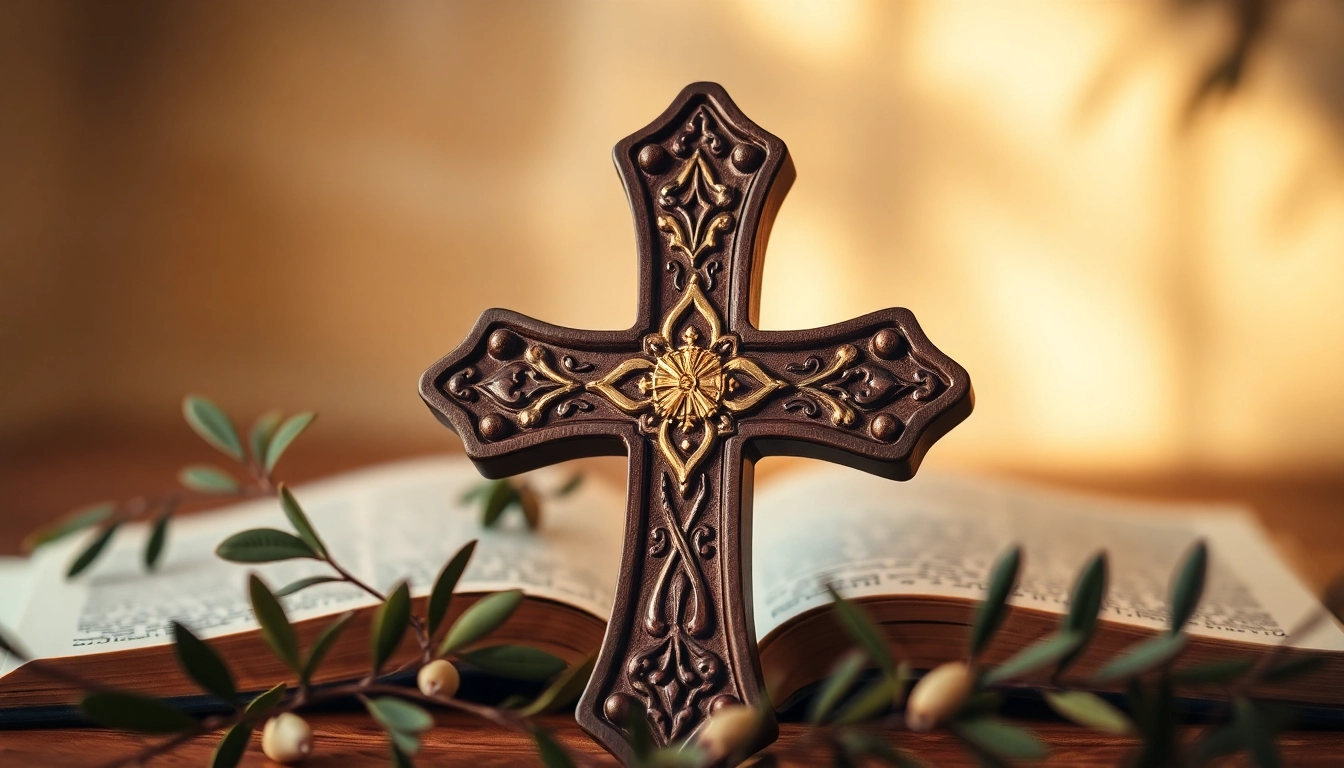The Historical Background of Jerusalem crosses
Origin and Meaning
The Jerusalem crosses hold a profound place in Christian heritage, particularly noted for their intricate symbolism and historical significance. The cross variant commonly features a large central cross potent—characterized by its arms that are wider at the ends—surrounded by four smaller Greek crosses, each positioned in the quadrants. This design serves as a visual representation of the faith’s evangelistic outreach, symbolizing the spread of the Gospel to the four corners of the earth, inspired by the teachings of the Four Evangelists: Matthew, Mark, Luke, and John. The Jerusalem cross is also known colloquially as the “Crusader’s Cross,” owing to its association with the Kingdom of Jerusalem during the Crusades era.
Evolution Through Centuries
Tracing back to the 11th century, the Jerusalem crosses have undergone significant transformations throughout history. Initially established as a symbol of the crusader conquest and the establishment of Christian dominion in Jerusalem, the cross became a potent emblem of faith and identity for Christians within the Crusader Kingdom. As the centuries progressed, its symbolism began to evolve, taking on various meanings across different Christian traditions and cultures. Its enduring presence is a testament to its historical roots and ongoing relevance in contemporary Christian symbolism.
Symbolism Associated with Jerusalem crosses
The Jerusalem crosses encapsulate a plethora of meanings, extending beyond mere representation of Christianity. Each element of the cross design warrants a variety of interpretations. The central cross signifies Christ’s victory over death, while the four smaller crosses symbolize the Evangelists. Together, they formulate a visual narrative of the Christian mission to spread the Gospel universally. Additionally, variations of the cross have emerged; for example, the Jerusalem cross is sometimes depicted with colors representing various aspects of the spiritual journey, such as hope, faith, and redemption.
Design Elements of Jerusalem crosses
Components of the Cross Design
The ornate design of the Jerusalem crosses is rich in meaning and artistry. The large central cross focuses the viewer’s attention, symbolizing Christ’s central role in the Christian faith. The smaller crosses, often referred to as crosslets, strategically reinforce this narrative of proclamation and dissemination of the Christian message. Artists and craftsmen have played with various styles and embellishments, ranging from simple wood carvings to exquisitely decorated metalwork adorned with precious stones, showcasing the skill and devotion of their creators.
Material and Craftsmanship
The craftsmanship behind the Jerusalem crosses varies significantly based on the materials used and the cultural context. Traditional versions are often made from wood, notably olive wood, recognized for its durability and symbolism as a tree native to the Holy Land. Alternatively, crosses can be constructed from metals such as silver and gold, highlighting opulence and devotion in religious settings. The craftsmanship often reflects the cultural influences of the regions where these crosses were produced, providing a unique blend of artistic expression and spiritual significance.
Variations Across Cultures
The Jerusalem crosses exhibit numerous variations that reflect diverse cultural interpretations. For instance, Eastern Orthodox traditions might incorporate specific iconographical elements into their renditions, often depicting saints or biblical scenes alongside the cross itself. In contrast, Western designs might emphasize a more simplistic, stylized approach focusing on the cross’s form. This cultural plurality enriches the iconography of the Jerusalem cross, allowing it to resonate with various communities and adapt to distinct ceremonial contexts.
Religious Significance of Jerusalem crosses
Role in Christian Traditions
In Christian traditions, the Jerusalem crosses play an integral role during religious services, symbolizing the core tenets of the faith. They often feature prominently in liturgical practices, adorn church architecture, and are presented during sacraments and celebrations. By serving as a visual representation of faith, the cross helps congregants connect with the foundational beliefs of Christianity, particularly notions of redemption, sacrifice, and hope.
Connection to the Four Evangelists
As a direct representation of the Four Evangelists, the Jerusalem crosses invite deeper contemplation on the origin and dissemination of the Christian Gospel. Each smaller cross emanates the teachings and narratives attributed to each Evangelist, underscoring their unique contributions to the New Testament. This connection not only enriches the spiritual experience but also emphasizes the unity and diversity of the Christian message, as these four perspectives collaboratively convey the life and mission of Jesus Christ.
Usage in Modern Worship
In contemporary worship settings, the Jerusalem crosses manifest various uses, from personal adornments to collective displays in church sanctuaries. Many believers wear cross pendants or include them in their home altar setups, reflecting their inward faith journey. Furthermore, churches often utilize Jerusalem crosses in tournaments, processions, and commemorative events, reinforcing their status as a symbol of unity among Christians worldwide. Their versatility makes them a focal point in both personal and community expressions of faith.
Jerusalem crosses in Art and Culture
Portrayal in Artistic Mediums
The artistic portrayal of the Jerusalem crosses spans a myriad of styles and mediums. Throughout the centuries, artists have captured their essence in paintings, sculptures, and modern digital forms. Historical paintings often depict the crosses in majestic settings, symbolizing religious triumphs and moments of devotion, while contemporary artists have reinterpreted their forms to engage modern audiences. Public art installations sometimes utilize the Jerusalem cross to explore themes of faith, identity, and resilience in the face of adversity.
Representation in Literature
Literature has long engaged with the theme and symbolism of the Jerusalem crosses, appearing in theological discourses, poetry, and even fictional narratives. Writers reflect on the weight of its symbolism, exploring ideas related to sacrifice and deliverance. In various literary contexts, the cross acts as a motif of hope or a dilemma of faith, ranging from secular interpretations to deeply spiritual epiphanies.
Contemporary Interpretations
Modern interpretations of the Jerusalem crosses demonstrate a dynamic intersection between tradition and contemporary life. Artists and theologians have begun to infuse elements of social justice, peace, and interfaith dialogue into the discussions surrounding the cross. Diverse perspectives stimulate broader conversations about faith’s role in a global society, highlighting the ongoing relevance of the Jerusalem cross as a symbol of hope and unity amid division.
How to Incorporate Jerusalem crosses in Daily Life
Displaying in Homes
Incorporating the Jerusalem crosses into home decor presents an opportunity to express personal faith and commitment. Many individuals choose to display the cross prominently in living spaces, using it as a reminder of their principles. These displays can take various forms, from intricate wall art to simple tabletop decorations. Moreover, positioning the cross near areas where family members gather, such as dining rooms or living rooms, can inspire constructive conversations about faith and spirituality.
Wearing as a Symbol of Faith
Wearing the Jerusalem crosses as jewelry has become a popular practice for many Christians seeking to express their beliefs outwardly. Cross necklaces or bracelets serve as daily reminders of one’s faith and commitment to Christ’s teachings. Selecting designs that resonate personally can enhance the sentimental value, serving as conversation starters about spiritual journeys and beliefs with others.
Giving as Gifts
The act of gifting Jerusalem crosses carries a profound significance within Christian communities. Such gifts are often bestowed during important life milestones such as baptisms, confirmations, and weddings, offering recipients not just a physical object but a symbol of faith and blessings. This practice fosters emotional connections and serves as a tangible expression of love, encouragement, and hope.



